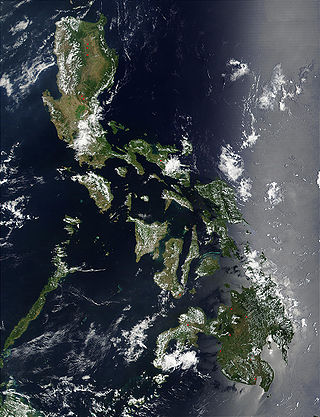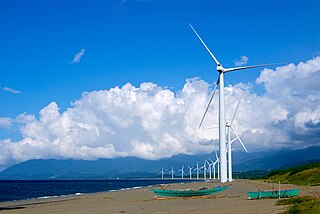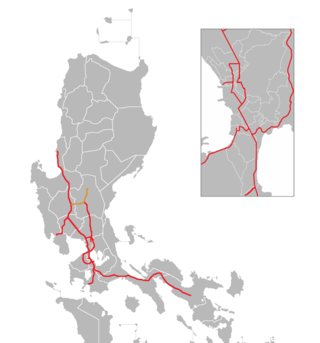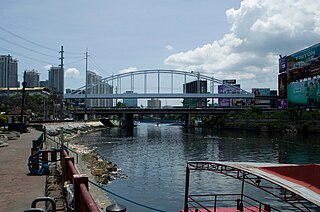Related Research Articles

The Philippines is an archipelago that comprises 7,641 islands, and with a total land area of 300,000 square kilometers (115,831 sq mi), it is the world's fifth largest island country. The eleven largest islands contain 95% of the total land area. The largest of these islands is Luzon at about 105,000 square kilometers (40,541 sq mi). The next largest island is Mindanao at about 95,000 square kilometers (36,680 sq mi). The archipelago is around 800 kilometers (500 mi) from the Asian mainland and is located between Taiwan and Borneo.

Laguna de Bay, also known as Laguna Lake and alternatively spelled "Laguna de Bae", is the largest lake in the Philippines. It is located southeast of Metro Manila, between the provinces of Laguna to the south and Rizal to the north. A freshwater lake, it has a surface area of 911–949 km2, with an average depth of about 2.8 meters and an elevation of about one meter above sea level. The lake is shaped like a crow's foot, with two peninsulas jutting out from the northern shore and filling the large volcanic Laguna Caldera. In the middle of the lake is the large island of Talim.

The Ilocos Region, designated as Region I, is an administrative region of the Philippines. Located in the northwestern section of Luzon, it is bordered by the Cordillera Administrative Region to the east, the Cagayan Valley to the northeast and southeast, Central Luzon to the south, and the South China Sea to the west.

Vigan, officially the City of Vigan, is a 4th class component city and capital of the province of Ilocos Sur, Philippines. According to the 2020 census, it has a population of 53,935 people.

Bangui, officially the Municipality of Bangui, is a 4th class municipality in the province of Ilocos Norte, Philippines. According to the 2020 census, it has a population of 15,019 people.

Piddig, officially the Municipality of Piddig is a 3rd class municipality in the province of Ilocos Norte, Philippines. According to the 2020 census, it has a population of 22,475 people.

Bantay, officially the Municipality of Bantay, is a 3rd class municipality in the province of Ilocos Sur, Philippines. According to the 2020 census, it has a population of 37,118 people. It is situated just north-east of Vigan, the provincial capital.

Teófilo E. Yldefonso was a Filipino breaststroke swimmer. He was the first Filipino and Southeast Asian to win an Olympic medal, and the first Filipino to win multiple medals.

The La Mesa Dam and Reservoir is an earth dam in Quezon City, Philippines. Its reservoir can hold up to 50.5 million cubic meters, occupying an area of 27 square kilometers (10 sq mi). It is part of the Angat-Ipo-La Mesa water system, which supplies most of the water in Metro Manila.
Daniel Zane Coakley is a Filipino-American swimmer who won two gold medals and a silver medal at the 2007 Southeast Asian Games. He competed in the 50 m freestyle at the 2008 Olympics, but failed to reach the final. Coakley is a great-grandson of Olympic medalist in swimming Teófilo Yldefonso.

The Central Luzon Link Expressway (CLLEX), also known as the Central Luzon Link Freeway, is a partially operational expressway in the Central Luzon region of the Philippines. It will connect the Subic–Clark–Tarlac Expressway (SCTEX) and the Tarlac–Pangasinan–La Union Expressway (TPLEX) to the currently under-construction North Luzon East Expressway in Cabanatuan towards San Jose, Nueva Ecija. It is currently toll-free and exclusively open to Class 1 vehicles but it will be tolled and opened to other classes of vehicles in the future.

Tuburan Kontong Tamse was a Filipino athlete, and the first Muslim Filipino Olympian.

The Metro Manila Subway, formerly known as the Mega Manila Subway (MMS) is an under-construction underground rapid transit line in Metro Manila, Philippines. The 33-kilometer (21 mi) line, which will run north–south between Valenzuela, Quezon City, Pasig, Taguig, Parañaque and Pasay, consists of 17 stations between the East Valenzuela and Bicutan stations. It will become the country's second direct airport rail link after the North–South Commuter Railway, with a branch line to Ninoy Aquino International Airport.

The Guadalupe Bridge is a road bridge crossing the Pasig River in Metro Manila, the Philippines, linking the cities of Makati and Mandaluyong. It serves as a conduit for EDSA and the MRT Line 3.

The North–South Commuter Railway, also known as the Clark–Calamba Railway, is a 147-kilometer (91-mile) commuter rail system under construction on the island of Luzon in the Philippines. Running from New Clark City in Capas, Tarlac, to Calamba, Laguna, with 36 stations and four services, the railway is designed to improve connectivity within the Greater Manila Area and will be integrated with the railway network in the region.

The Philippines competed at the 2020 Summer Olympics in Tokyo. Originally scheduled to take place from 24 July to 9 August 2020, the Games were postponed to 23 July to 8 August 2021 due to the COVID-19 pandemic. Since the nation's official debut in 1924, Filipino athletes have appeared in every edition of the Summer Olympic Games except the 1980 Summer Olympics in Moscow because of the nation's partial support for the US-led boycott.

The PNR North Main Line is one of the two trunk lines of the Philippine National Railways in the island of Luzon, the other being the PNR South Main Line. The line during its maximum extent led to various cities and municipalities in Central Luzon and the Ilocos Region.
References
- ↑ "Mendoza: Quality Olympics finish for PHL". ph.news.yahoo.com. Retrieved 2021-08-23.
- ↑ "Guisit River stream, Ilocos, Philippines". ph.geoview.info. Retrieved 2021-08-22.
- ↑ "JICA報告書PDF版" (PDF). openjicareport.jica.go.jp.
- ↑ "Teofilo YLDEFONSO". Olympics.com. Retrieved 2021-08-23.
- ↑ "First Pinoy Olympic medalist has no known grave". Manila Bulletin. 2021-07-30. Retrieved 2021-08-23.
- ↑ "PH's first Olympic medalist Teofilo Yldefonso: An officer and a sportsman". l!fe • The Philippine Star. Retrieved 2021-08-23.